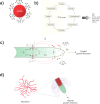Exploiting Micrometer-Scale Replication of Fungal Biotemplates for Multifunctional Uses in Electrochemistry and SERS Substrates
- PMID: 39493990
- PMCID: PMC11525492
- DOI: 10.1021/acsomega.4c03431
Exploiting Micrometer-Scale Replication of Fungal Biotemplates for Multifunctional Uses in Electrochemistry and SERS Substrates
Abstract
In this paper, filamentous fungi have been used as biotemplates to integrate gold nanoparticles (Au-NPs) into the cell wall. A new chemical mechanism has been proposed to elucidate the assimilation of Au-NPs by fungi, considering the ionic current that arises in the function of fungal metabolism. After biological components were eliminated, mycelium-like gold microtubes have been obtained using different fungal species as precursors. Mycelium-like gold microtubes replicate the biological shape of fungi, presenting inherent multifunctionality. This work presents two promising applications for this material: high surface area electrodes for electrochemical experiments and substrates for SERS detection of organic molecules such as Rhodamine 6G.
© 2024 The Authors. Published by American Chemical Society.
Conflict of interest statement
The authors declare no competing financial interest.
Figures







References
-
- Mann S.; Ozin G. A. Synthesis of inorganic materials with complex form. Nature 1996, 382 (6589), 313–318. 10.1038/382313a0. - DOI
-
- Nassif N.; Livage J. From diatoms to silica-based biohybrids. Chem. Soc. Rev. 2011, 40 (2), 849–859. 10.1039/C0CS00122H. - DOI - PubMed
- Sicard C.; Brayner R.; Margueritat J.; Hemadi M.; Coute A.; Yepremian C.; Djediat C.; Aubard J.; Fievet F.; Livage J. Nano-gold biosynthesis by silica-encapsulated micro-algae: a ″living″ bio-hybrid material. J. Mater. Chem. 2010, 20 (42), 9342–9347. 10.1039/c0jm01735c. - DOI
-
- Pandit P.; Rananaware P.; D’Souza A.; Kurkuri M. D.; Brahmkhatri V. Functionalized diatom biosilica decorated with nanoparticles: synthesis, characterization, catalytic oxidation, and dye scavenging applications. J. Porous Mater. 2022, 29 (5), 1369–1383. 10.1007/s10934-022-01262-w. - DOI
-
- Campbell B.; Ionescu R.; Tolchin M.; Ahmed K.; Favors Z.; Bozhilov K. N.; Ozkan C. S.; Ozkan M. Carbon-Coated, Diatomite-Derived Nanosilicon as a High Rate Capable Li-ion Battery Anode. Sci. Rep. 2016, 6 (1), 33050.10.1038/srep33050. - DOI - PMC - PubMed
- Wang M. S.; Fan L. Z.; Huang M. A.; Li J. H.; Qu X. H. Conversion of diatomite to porous Si/C composites as promising anode materials for lithium-ion batteries. J. Power Sources 2012, 219 (219), 29–35. 10.1016/j.jpowsour.2012.06.102. - DOI
LinkOut - more resources
Full Text Sources
Miscellaneous
